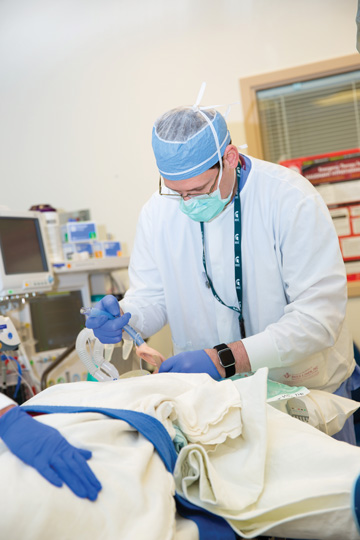If a patient has been cleared for deep sedation, the anesthesia provider must closely monitor the patient to make sure air is flowing in and carbon dioxide is flowing out of them.
Dr. Philips calls this “qualitative” monitoring.
“If you have a breathing tube in, you can measure the carbon dioxide and get a nice number you can follow,” she says.
Deep sedation cases don’t offer that luxury, so constant visual observation is required to ensure the patient is breathing — and immediate action is required if they are having difficulty. “If I have an unexpected issue, I go
through an airway management algorithm in my head,” says Dr. Wiesenberger.
Much like depth of sedation, airway management interventions exist on a continuum:
• Add oxygen where possible. “Sometimes this is problematic, because if the surgery is happening around the face and the surgeon is using electrocautery, you can’t use much extra oxygen because it’s a fire hazard,”
says Dr. Philip, who administers a diluted oxygen/air mixture in such cases.
• Perform chin lifts and jaw thrusts. Dr. Wiesenberger is vigilant because the various drugs he may use to hit numerous receptors at multiple times can lead to shallow breathing, an obstructed airway or apnea in the patient. “At
that point, you need to begin with a gentle jaw thrust,” he says. “You can do a rigorous job if it’s needed, but the patient can have some jaw tenderness the next day, and if you push down really hard, they could experience
lip numbness.”
• Place oral or nasal airways. Deciding between these two options is a matter of situation and provider preference. “They’re interchangeable enough for this purpose,” says Dr. Philip.
The majority of the time,
these maneuvers will get the patient breathing. If not, more intensive action must be initiated. When additional interventions are needed, Dr. Wiesenberger first grabs a manual resuscitator to ventilate the patient. Because the agents used
in deep sedation — such as midazolam, fentanyl and propofol — either quickly wear off or can be reversed, the patient should emerge safely.
“If you’re unable to ventilate, however, now you’re in the scary zone,” he says. “At that point you call an emergency, and everybody stops what they’re doing.” The patient must be placed on their back,
and if another anesthesia provider is in the building, they should assist, says Dr. Wiesenberger.
After administering paralytics to try to relax the airway, Dr. Wiesenberger begins to insert a tube between the vocal cords to secure the airway, then hooks the patient to a ventilator. If he’s still unable to intubate the patient, he tries
to secure the airway with an LMA. If that doesn’t work, he might have to perform an emergency cricothyrotomy.
In a real catastrophe, Dr. Wiesenberger says, the patient will go into respiratory distress, then respiratory failure, then cardiovascular collapse. “Thankfully, that’s an incredibly rare phenomenon, or we would not be doing these
cases in the outpatient setting,” says Dr. Wiesenberger.
.svg?sfvrsn=be606e78_3)


.svg?sfvrsn=56b2f850_5)